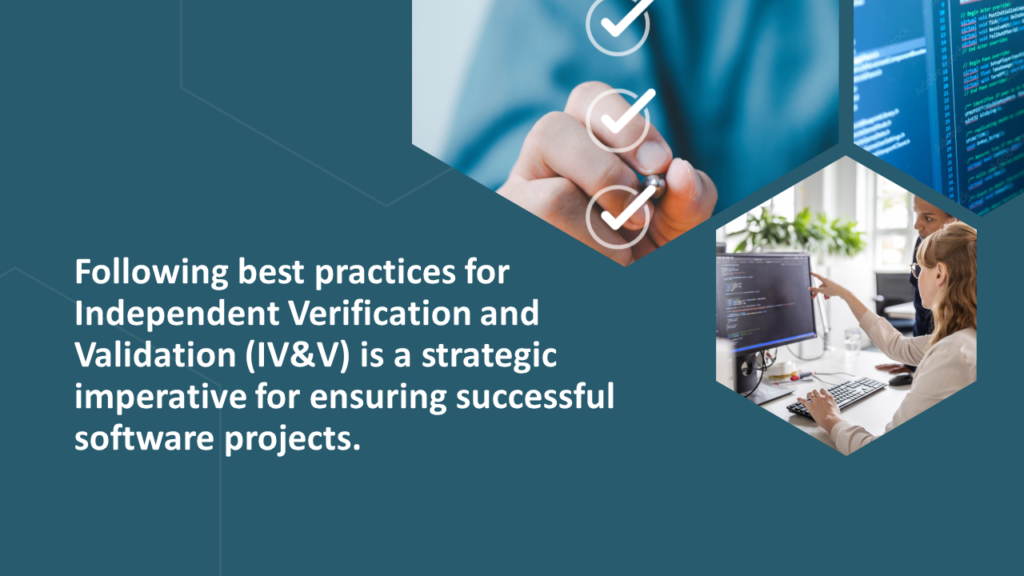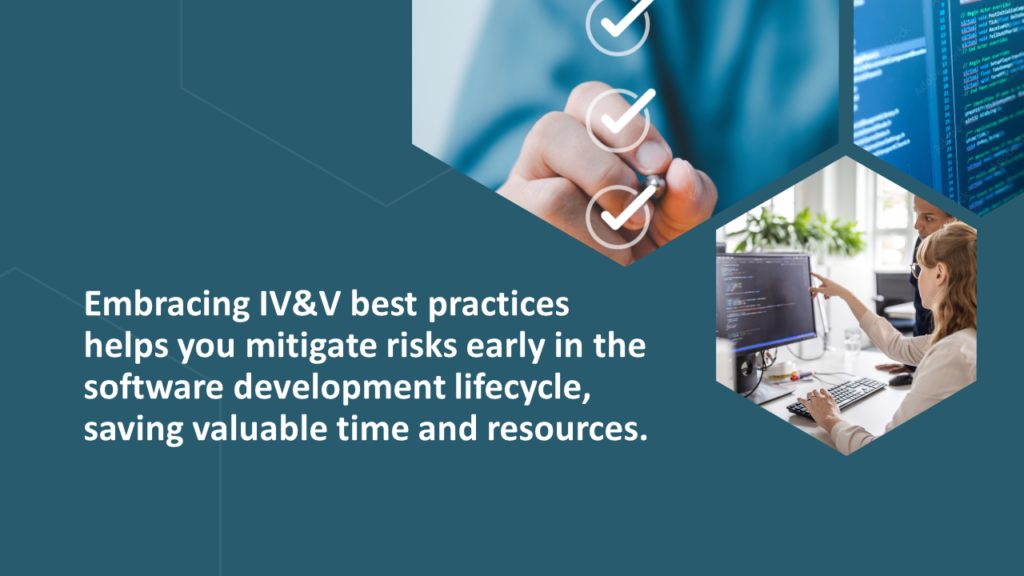Best Practices for Effective Independent Verification and Validation (IV&V) in Software Evaluation
In the fast-paced world of software development, ensuring the reliability, functionality, and security of software applications is paramount. Independent Verification and Validation (IV&V) is a rigorous process that plays a crucial role in evaluating software to identify and rectify potential issues before deployment. In this blog, we’ll delve into the best practices for utilizing IV&V to effectively evaluate software, ensuring its quality and success.
Understanding IV&V
IV&V is a systematic and comprehensive process that involves an independent assessment of a software system’s design, implementation, and performance. It aims to ensure that the software meets its intended requirements, functions as expected, and is free from critical errors and vulnerabilities. The IV&V process typically involves a team of experts who are not directly involved in the development of the software.
Best Practices for IV&V
Following best practices for Independent Verification and Validation (IV&V) is not just a recommended approach – it is a strategic imperative for ensuring the success of your software projects. By adhering to established IV&V best practices, you are proactively safeguarding your software’s integrity, functionality, and security. These practices are designed to systematically identify potential issues, vulnerabilities, and shortcomings that may remain hidden within your software, posing risks that could lead to operational disruptions, security breaches, or even regulatory non-compliance.
Embracing IV&V best practices helps you mitigate these risks early in the software development lifecycle, saving valuable time, resources, and potential reputational damage down the line. A thorough IV&V process aids in verifying that your software aligns with its intended purpose and meets or exceeds industry standards and user expectations. Furthermore, it provides a structured framework for uncovering and addressing performance bottlenecks, coding errors, and design flaws that could impede the software’s seamless functioning. By diligently following IV&V best practices, you are not only enhancing the overall quality of your software but also fostering a culture of continuous improvement and excellence within your organization.
With this in mind, we have put together a list of best practices for IV&V for you to consider:
1. Early Involvement:
Effective IV&V starts from the early stages of software development. By involving IV&V experts during the requirements gathering and design phases, potential issues can be identified and addressed before they become deeply embedded in the system. Early involvement also facilitates better understanding of the software’s purpose, scope, and expected outcomes.
2. Clearly Defined Objectives:
Before initiating IV&V, it’s essential to establish clear and measurable objectives. Define what aspects of the software you’re evaluating, what specific criteria you’re assessing, and what goals you aim to achieve through the IV&V process. Having well-defined objectives provides focus and helps in measuring the success of the evaluation.
3. Independence and Neutrality:
To ensure an unbiased assessment, the IV&V team should be independent from the development team. This independence allows for an objective evaluation, free from any conflicts of interest. The IV&V experts should maintain neutrality and avoid getting influenced by the development process or any internal pressures.
4. Comprehensive Testing:
Thorough testing is at the heart of IV&V. It involves various testing methodologies, such as functional testing, performance testing, security testing, and usability testing. Rigorous testing helps uncover defects, vulnerabilities, and inconsistencies in the software. The testing scope should cover all relevant aspects of the software, leaving no stone unturned.
5. Risk Assessment:
Identifying and prioritizing risks is a critical aspect of IV&V. By conducting a risk assessment, the IV&V team can focus their efforts on evaluating high-priority areas that are most likely to impact the software’s performance or reliability. This ensures efficient resource allocation and a more targeted evaluation process.
6. IV&V Documentation and Traceability:
Effective documentation is key to a successful IV&V process. Document all the evaluation processes, methodologies, findings, and recommendations. This documentation provides a clear trail of the assessment and serves as a valuable resource for future reference. Traceability ensures that issues are addressed and resolved systematically.
7. Collaboration and Communication:
Maintain open and transparent communication between the IV&V team, the development team, and stakeholders. Regular updates, status reports, and feedback sessions facilitate a collaborative environment and ensure that everyone is on the same page regarding the evaluation progress and outcomes.
8. Continuous Monitoring:
IV&V is not a one-time event; it should be an ongoing process throughout the software development lifecycle. Continuously monitor the software’s performance and address any emerging issues promptly. Regular evaluations help maintain the software’s quality and address new challenges as they arise.
9. IV&V Expertise and Skillset:
Assembling a skilled and knowledgeable IV&V team is crucial. The team should possess expertise in various domains, including software development, testing methodologies, security practices, and industry standards. Their diverse skillset ensures a comprehensive evaluation of the software from multiple angles.
10. Adaptability and Flexibility:
Software projects can be dynamic, with changes in requirements, scope, and technology. The IV&V process should be adaptable and flexible enough to accommodate these changes. Adjust the evaluation approach as needed to ensure that the assessment remains relevant and effective.
IV&V stands as a pillar of quality assurance and risk mitigation. By adhering to these best practices, organizations can harness the power of IV&V to evaluate software effectively, identify potential issues, and enhance the overall reliability, functionality, and security of their software applications. Through early involvement, comprehensive testing, clear communication, and a commitment to continuous improvement, IV&V becomes a valuable tool in delivering successful software solutions that meet user expectations and industry standards.
Selecting an IV&V Vendor
Selecting the ideal Independent Verification and Validation (IV&V) vendor is a crucial decision that can significantly impact the success of your software project. A thoughtful and strategic approach to this selection process is essential to ensure that your software undergoes a comprehensive and unbiased evaluation. First and foremost, consider the vendor’s expertise and track record in IV&V. Look for a vendor with a proven history of successful IV&V engagements, particularly in your industry or domain. Their experience should align with the complexities and requirements of your software, whether it’s in healthcare, aerospace, finance, or any other field.
Transparency and open communication are paramount when choosing an IV&V vendor. Seek a vendor that demonstrates a willingness to collaborate and engage in clear and consistent communication. The vendor should be receptive to understanding your software’s unique characteristics, objectives, and challenges. During the selection process, assess their communication style, responsiveness, and their approach to sharing findings, recommendations, and progress updates. A vendor that values transparency not only fosters a strong working relationship but also ensures that you are well-informed about the evaluation process, findings, and potential areas for improvement. Additionally, inquire about their reporting mechanisms – a robust reporting structure that presents results in a clear and actionable manner is indicative of a vendor’s commitment to providing insights that drive meaningful software enhancements.
With a solid track record in Independent Verification and Validation (IV&V), i3solutions brings a wealth of expertise to ensure the quality, reliability, and security of your software solutions. For over 25 years, we have successfully partnered with a diverse range of clients across various industries, from cutting-edge technology startups to established enterprises. Our IV&V experience extends to critical sectors such as government contracting, healthcare, and finance, where our meticulous evaluation process has played a pivotal role in identifying potential issues and enhancing software performance. Through a collaborative and transparent approach, we have consistently delivered actionable insights and recommendations, empowering our clients to make informed decisions that lead to software excellence. Our commitment to staying at the forefront of industry trends, coupled with our dedicated team of experts, makes i3solutions a trusted partner for organizations seeking comprehensive IV&V that goes beyond conventional testing, resulting in software that stands out in terms of quality and robustness.
Contact us today for more information about i3solutions’ IV&V services or to discuss your specific IV&V needs.
Leave a Comment




